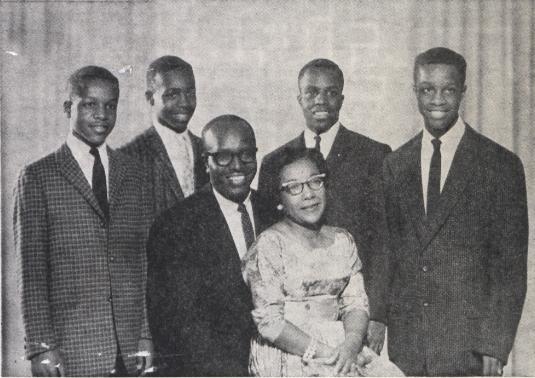Maurice Coakley and Sioux Falls' Civil Rights Movement

The bus boycotts of Montgomery, Alabama, or the lunch counter sit-ins of Nashville, Tennessee often serve as anchor points for histories of the Civil Rights Movement, which focus attention on the South. In Sioux Falls, South Dakota, Maurice Coakley helped lead the fight for equal housing and voting rights within his own state, showing that civil rights struggles extended into the North and Midwest.
The Civil Rights Movement was not confined to the American South, but a far-reaching national struggle for equal rights. In 1962, U.S. Congress introduced a constitutional amendment that would outlaw the practice of collecting poll taxes in federal elections, a tool used to suppress African American voting participation since Reconstruction. In South Dakota, the national NAACP organization called on longtime Black leader, Ted Blakey of Yankton, to form a committee to push the State Legislature to ratify the amendment. Blakey invited Maurice Coakley of Sioux Falls to the Committee on Human Rights, along with Dr. Arnett Matchett, Ben Hamilton, and Bill Mahone. Maurice discussed his work with the committee, particularly on racial discrimination at businesses, recalling that they "set up a task force that would go out and try to promote this and see which ones they were and then put them down in order and then bring it to a full Civil Rights Commission of the state. So that the pressure could be put on these places to be in compliance with the law.”
Coakley and the committee members also cranked up pressure on legislators to ratify the new amendment. On January 23, 1964, the State Legislature voted to approve the 24th Amendment, making South Dakota the final state needed to reach the constitutional threshold of three-quarters of all states. In 1967, following the success of the public campaign orchestrated by the Committee, Coakley and Blakey were asked to establish the first statewide chapter of the NAACP in South Dakota. Due to community support he both received and provided, Maurice Coakley became a central figure in the civil rights struggles in Sioux Falls.
Coakley’s participation in civil rights was predicated on the social and economic stability he obtained from the Sioux Falls community. Born November 11, 1914, in Kentucky, Maurice moved to Fergus Falls, Minnesota, at six years old with his parents, Samuel and Katie Coakley, as part of the “Great Migration” of African Americans who left the Jim Crow South between the World Wars. In 1930, the Coakley family relocated again to Sioux Falls, South Dakota. Due to marital troubles with his parents, Maurice lived at the Booker T. Washington Service Center his last two years of Washington High School until he graduated. Maurice was employed by Mener and Lizzie Greer, an African American family who owned and operated an auto repair garage. After earning a high school diploma, Coakley worked at the Stockyards, sorting cattle, pigs, and sheep for meat processing at John Morell and Company. After nine years working there, Maurice was hired as a federal meat inspector for the U.S. Bureau of Animal Industry in 1942. Maurice spent four years working as a meat inspector until he decided to start his own business in Sioux Falls, Coakley Porter Service. Coakley married Clarice Sheriffe of Mason City, Iowa, who had trained as a hairdresser at Louisa Mitchell’s California School of Beauty, on December 22, 1935. Maurice and Clarice had four boys, Maurice Jr., Eugene, Edward, and Daniel.
Like voting rights, equal housing became one struggle for the Civil Rights Movement. Unlike the well-documented examples of “redlining” minority neighborhoods as hazardous in Sioux City, Iowa, or racial restrictive covenants in Minneapolis, Minnesota, the scope of housing segregation in Sioux Falls is unclear (until future deed research is completed). One restrictive covenant from 1941 was found in the Columbia Heights subdivision (north of 22nd St. and west of S. Western Ave.) stating that the property “shall never be owned or occupied except by some one of the Caucasian race, except such as in the employ of the owner.” Interviewees, including Maurice’s son Ed Coakley, shared that living south of 26th St. was considered a de facto racial barrier for the African American community in Sioux Falls.
In 1950, Maurice and Clarice Coakley bought a house at 1921 S. Summit Ave., located one block north of Augustana College, working directly with a building contractor to avoid the possible discriminatory practice of bank mortgage denial. The Coakleys joined George and Alice Vaughn at 1901 S. Euclid Ave. (in 1953) and Alfred and Bertha White at 1808 S. Menlo Ave. (in 1954) as some of the first African American homeowners outside of the historically Black north end of the city. In the context of racial segregation, the freedom to live wherever one pleased was a Civil Rights victory in Sioux Falls. Maurice would offer up his family home to Democratic Party candidates who backed civil rights as a headquarters for the local precinct during state and federal elections.
Coakley Residence at 1921 S. Summit Ave
Maurice was an active member of the St. John’s Baptist Church in Sioux Falls which was a major component of the Civil Rights Movement. St. John’s was instrumental in bringing the most prominent civil rights leader, Rev. Dr. Martin Luther King Jr., to Sioux Falls in 1961. While King led the Southern Christian Leadership Conference; the work done in the northern states was by individuals such as Maurice Coakley, Ted Blakey, and many others. While their efforts may not get as much attention as work done in the southern states, it is imperative that we do not let their fight for the equality go unappreciated.
Images


